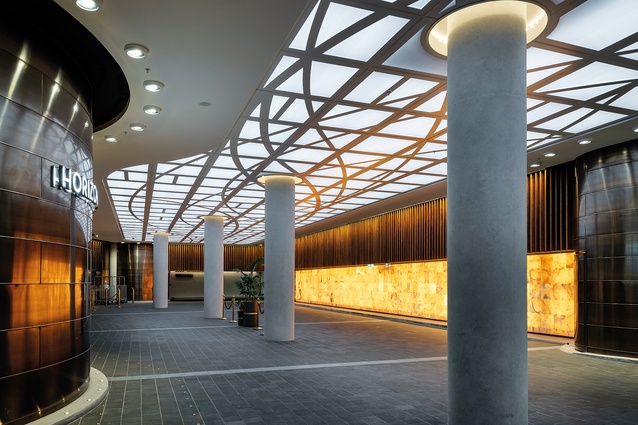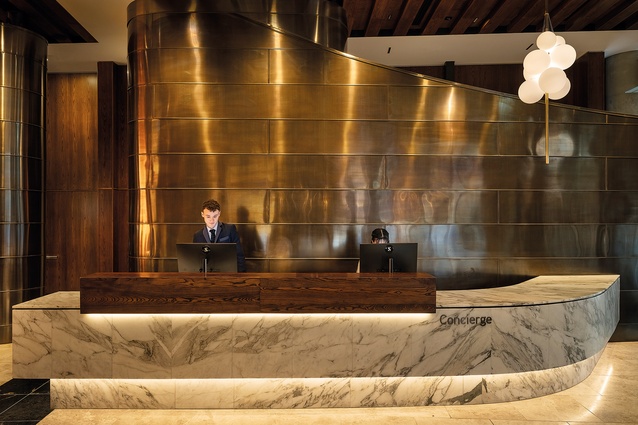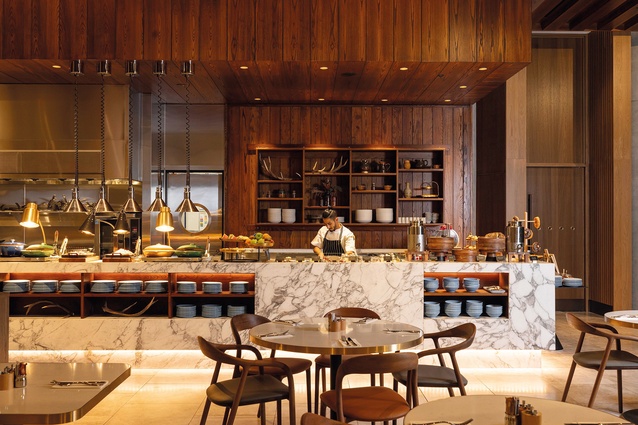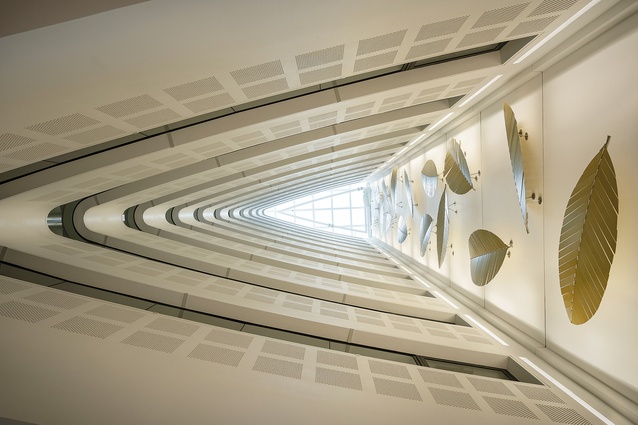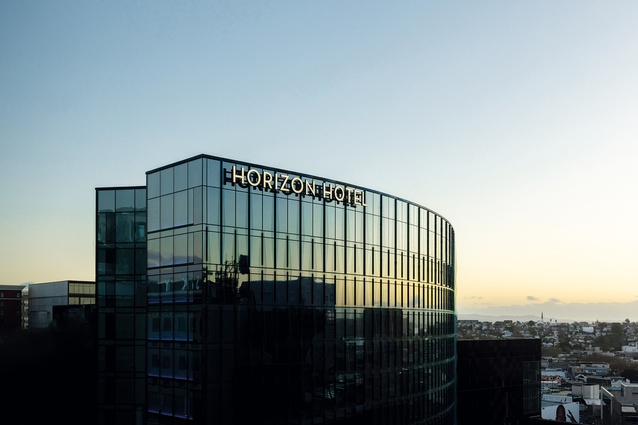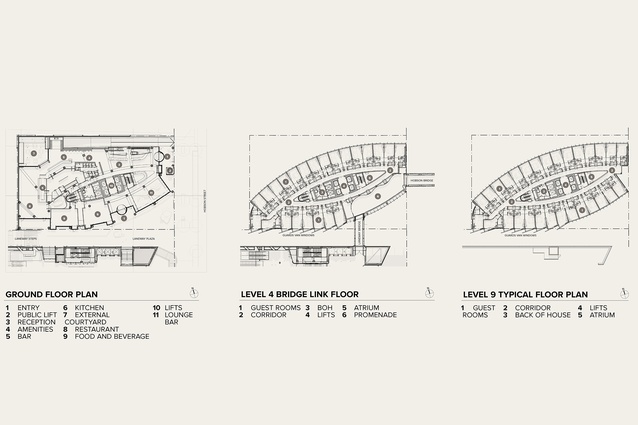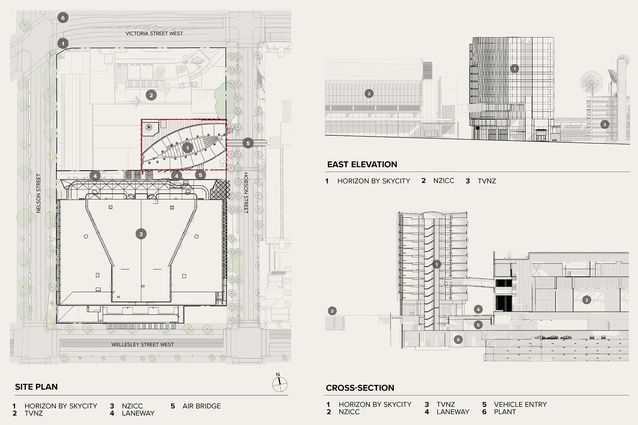Unfolding treasure boxes
Bill McKay goes inside the crafted luxury of Horizon by SkyCity, by Moller Architects in association with Warren and Mahoney.
This building looks so simple from the street: a hotel is a lobby, maybe a restaurant and kitchen, definitely some back-of-house stuff and then a simple stack of rooms, right? This one has a nice elliptical plan, that’s a gesture dreamed up by the architect, right? Wrong. Life and the architecture that wraps itself around our lives and diverse needs and complicated relationships is more… complicated, of course. Having a lovely day, we are enjoined by our baristas as we slope out the door in the morning, but night is a different story, after navigating everything chucked at us all day long. Home is one thing, a comfortable cave if we are lucky, but a good hotel aspires to, and promises, more. As fashion designer Diane von Furstenberg puts it, “When you get into a hotel room, you lock the door, and you know there is a secrecy, there is a luxury, there is fantasy. There is comfort. There is reassurance.”
From Chaucer’s Canterbury Tales to today’s The White Lotus, travellers have made good drama and a good hotel’s job is to smooth it all over and allow us to experience, briefly, the fantasy that life can be nice. And elegant and effortless as well, if we can afford it. For a brief period, we can be swan-like, despite our own turmoil and tribulations, as well as, no doubt, furious behind-the-scenes and below-stairs effort by our temporary servants.
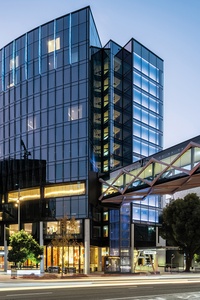
Auckland’s new Horizon Hotel (aka Horizon by SkyCity) is what it says on the label(s): a new hotel that’s part of the SkyCity empire, which extends across quite a few city blocks now. At the centre of this, of course, is the Sky Tower and the massive block-long building encompassing the dark heart of the casino, with its first hotel above and a huge underground car park below. Its size is tempered to the east by the smaller scale of Federal Street’s shared space lined with eateries and the SkyCity Grand Hotel, the complex’s second. To the west, however, Hobson Steet is a different story: a one-way multi-lane traffic corridor that’s essentially a motorway on-ramp. SkyCity’s third hotel is positioned across the default-highway and connected by a pedestrian bridge. The huge hull of that great behemoth, the new New Zealand International Convention Centre (NZICC for short, thanks), is to the south of the hotel and TVNZ (not affiliated to SkyCity, yet) is to the north. Horizon isn’t so much sandwiched between all this; it’s positioned to be a hinge between SkyCity and the NZICC, with links via two air bridges and a new laneway connecting Hobson Street to Nelson Street. Moller Architects and Warren and Mahoney collaborated on Horizon with Mollers being the design lead. “Collaborations can be fraught,” says Gordon Moller, “but this went very well”, Mollers having a team in the Warren and Mahoney office.
The site allocated for Horizon is actually square, but a corner was significantly clipped by a microwave path from TVNZ’s roof to a Waitākere Ranges transponder. A volcanic sight line was also an invisible intrusion on the site. These circumstances prompted a curved form on the TVNZ side of the site and reflecting that shape on the south side resulted in an overall elliptical building plan with services, vertical circulation and an atrium in the centre. The arc of the northern curve also serendipitously allowed an extra two harbour-view rooms to fit into that segment and, on the southern side, the curl to Hobson Street allows the laneway to open more invitingly to the street.
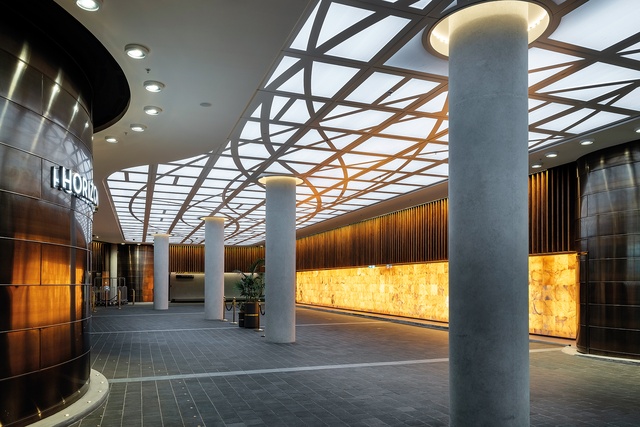
Let’s leave Hobson Street and go inside Horizon. The porte-cochère is less expansive than you’d like it to be when dropped off on a rainy Auckland day, thanks to the city’s council. I don’t know why. Hobson Street needs all the help it can get until sense prevails and it becomes a quieter two-way boulevard once again, focused on accommodating more people than just those in cars hell-bent for the highway.

The big surprise for those who will arrive at Horizon by car is that most won’t come this way; there is a second way in by car or coach via Nelson Street under the NZICC. The two structures have co-located a lot of building services and there is also a massive area here devoted to shunting punters in and out of both buildings; your carriage can convey you about a block underground to the base of the hotel where you will pull up under a large canopy. Actually, it’s an artificially lit ceiling but it gives a very good impression of daylight to anyone ‘fresh’ off an airliner. An entry, a plush little foyer and up the lifts and you’re in the Hobson Street ground-floor entry area: reception, lobby, restaurant, bars, all opening out one way or another. A courtyard, a bay off the street at the mouth of the laneway and the laneway itself, once the NZICC is finished, should be activated by a couple of little shops, and movement to and from the hotel, and those short-cutting from Nelson Street to Hobson in
a welcome laneway away from torrents of traffic.
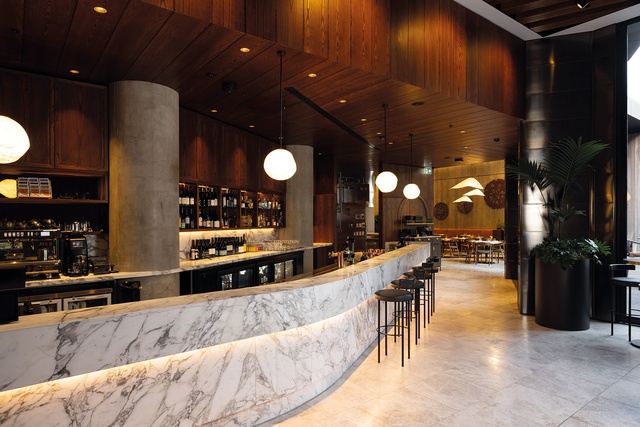
Horizon is a five-star hotel: New Zealand not international. I don’t know what the difference is but it is pretty lovely here with some gorgeous finishes; Moller especially mentioned the great suppliers and subbies on the project. The atrium is not as big as you may think but it soars vertically like a big tree in a small clearing in a forest, accentuated by a beautiful artwork of abstracted pōhutukawa leaves articulated in anodised aluminium. On the hotel levels, the elliptical nature of the plan means the corridors are single-loaded rather than double but I like that and the gloomy, forest-like lighting. The place is quieter, less busy, and each door is recessed back from the hallway, a few panels of timber shaping a tiny private alcove: a bubble of anticipation before entering your room. Von Furstenberg would like it and here is something she would love: the rooms themselves. The concept here was of a portmanteau or steamer trunk: that gigantic unfolding manifold house-in-a-suitcase that a 19th-century traveller would have staff cart around after them on tours of the Continent and elsewhere. It would magically appear in their room, as big as a wardrobe: a wunderkammer of their stuff in a foreign place.
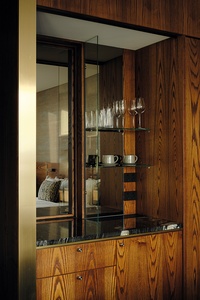
Horizon’s northern segment has expansive views to the harbour over the top of TVNZ and these sea-view rooms have fine little fins articulating the façade, a conscious reference to shellfish prompted by the elliptical plan tending towards an internal spiral. These fins are much more overt in the southern quarter, with what Moller calls ‘guards van windows’ after the rear carriage on a train, channelling your vision in a certain direction: in this case, to the west. No offence, NZICC, but that’s one big roof you have there and I’d rather avert my gaze to the distant green Waitākeres. There are 300ish guest rooms here and they come in a few different types, with interconnecting doors in some to allow suites or caregivers to have rooms next to accessible ones.
I have a side-hustle as a speaker on cruise ships, mostly six-star, and these rooms impressed me. They go well beyond the usual generic attention to detail and have lots of interesting, quirky-but-well-thought-out details, such as a hatch you can open in a bathroom to gaze at the view while brushing your teeth. It is not often a final design meets the expectations set by the concept, but these little rooms really are like treasure boxes with unfolding features, drawers, trays and so on for von Furstenberg’s bits and pieces and must-haves, as well as providing mise en scène for whatever else she had in mind that we could intuit from her list. Horizon is simple on the outside but it’s a simplicity that masks great complexity, like any good hotel or a nice oyster does.

